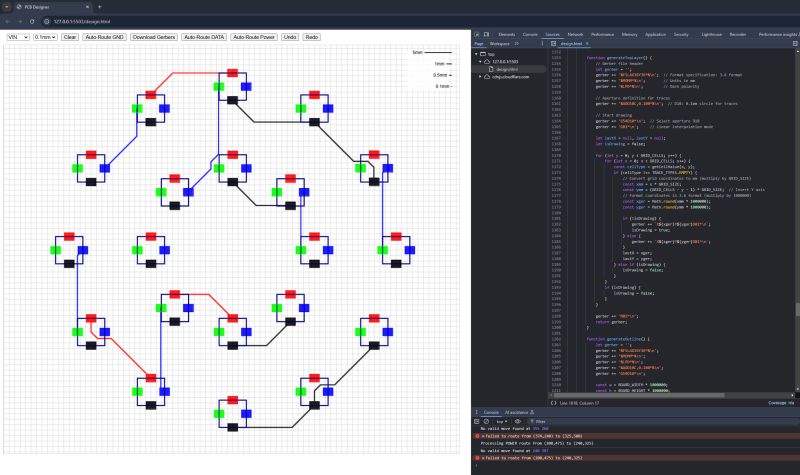I enjoy pushing AI to tackle ever harder problems, and recently I set myself an interesting challenge: could I create a functional PCB (Printed Circuit Board) design tool that runs entirely in a web browser, with no server needed? The answer, as it turns out, is a resounding yes—and it took only a couple of hours to build.
The Challenge
Traditional PCB design software like Altium Designer, KiCad, or Eagle are complex desktop applications with steep learning curves and significant resource requirements. I wanted to explore whether modern web technologies, combined with AI assistance, could create a more accessible alternative.
The goal was to build a tool that could handle:
- Manual trace routing between components
- Automatic routing algorithms
- Full undo/redo functionality
- Gerber file generation for manufacturing
- All running client-side in the browser
The AI-Assisted Development Process
Rather than spending weeks learning PCB design algorithms from scratch, I leveraged AI to accelerate the development process. Here's how I approached it:
1. Architecture Planning
I started by discussing the overall architecture with Claude, exploring different approaches to:
- Canvas-based rendering for the PCB layout
- Data structures for components, traces, and layers
- Algorithms for auto-routing and collision detection
- Gerber file format and generation
2. Component Implementation
The AI helped me implement each major component of the system:
- Component Library: Standard electronic components with proper pad layouts
- Manual Routing: Click-and-drag trace creation with real-time visual feedback
- Auto-routing: A simplified but functional maze-routing algorithm
- Layer Management: Support for multiple PCB layers
3. Advanced Features
What impressed me most was how quickly we could implement sophisticated features:
- Undo/Redo System: Full command pattern implementation
- Design Rule Checking: Basic validation for trace widths and spacing
- Export Functionality: Complete Gerber file generation
Technical Highlights
The resulting tool demonstrates several interesting technical achievements:

Pure Client-Side Operation
Everything runs in the browser using vanilla JavaScript, HTML5 Canvas, and modern web APIs. No server required means instant startup and complete privacy—your designs never leave your computer.
Gerber File Generation
One of the most complex aspects was implementing Gerber file export. Gerber is the standard format used by PCB manufacturers, and getting it right was crucial for the tool to be practically useful.
"A simple circuit with some LEDs and the resulting gerber file"
Auto-routing Algorithm
The auto-router uses a modified A* pathfinding algorithm optimized for PCB traces. While not as sophisticated as commercial tools, it successfully routes simple to moderately complex designs.
📱 Community Response
When I shared this project on LinkedIn, the response was overwhelming and encouraging:
"I enjoy pushing AI to tackle ever harder problems. Within a couple of hours, I created a relatively simple PCB design CAD that runs entirely in browsers with no server needed. Supporting manual traces, auto-routing, undo-redo and Gerber file generation."
The community's enthusiasm for rapid prototyping tools and AI-assisted development was incredible to see. Many engineers shared their own experiences with traditional PCB tools and expressed interest in more accessible alternatives.
What This Demonstrates
This project highlights several important trends in modern software development:
AI as a Development Accelerator
Rather than replacing human creativity, AI served as an incredibly effective research assistant and code generator. Complex algorithms that might take days to research and implement were completed in hours.
The Power of Modern Web Platforms
What once required desktop software can now run entirely in a browser. The web platform has become incredibly capable for complex applications.
Democratizing Specialized Tools
By lowering the barrier to entry, tools like this can make PCB design more accessible to hobbyists, students, and rapid prototyping scenarios.
Limitations and Future Improvements
While functional, this is still a proof-of-concept with several limitations:
- Limited component library compared to professional tools
- Simplified auto-routing that may not handle complex designs
- Basic design rule checking
- No 3D visualization or mechanical design features
However, the foundation is solid and could be extended with additional features as needed.
The Broader Implications
This experiment represents more than just a PCB design tool—it's a demonstration of how AI can accelerate the development of specialized software in domains where individual developers might not have deep expertise.
The same approach could be applied to other CAD applications, scientific computing tools, or any domain where traditional development requires extensive specialized knowledge.
Try It Yourself
The tool is available to try online, and the experience of building it has inspired me to explore other "impossible in a few hours" projects. Sometimes the best way to understand what's possible is to just start building and see how far you can get.
What would you build in a couple of hours with AI assistance? The possibilities are more extensive than you might think.